HPV E7 contributes to the telomerase activity of immortalized and tumorigenic cells and augments E6-induced hTERT promoter function
- PMID: 18367227
- PMCID: PMC2716003
- DOI: 10.1016/j.virol.2008.02.025
HPV E7 contributes to the telomerase activity of immortalized and tumorigenic cells and augments E6-induced hTERT promoter function
Abstract
The E6 and E7 proteins of high-risk HPVs are both required for the immortalization of primary human keratinocytes and the maintenance of the malignant phenotype of HPV-positive cancer cell lines. Our previous studies have shown that E6 protein binds Myc protein and that both E6 and Myc associate with and cooperatively activate the hTERT promoter, thereby increasing cellular telomerase activity. In this study, we evaluated the role of E7 in the maintenance and activation of telomerase in immortalized and tumorigenic cells. siRNA knockdown of either E6 or E7 (or both) in HPV-immortalized cells or an HPV-positive cancer cell line reduced hTERT transcription and telomerase activity. Since telomerase was inhibited by E7 siRNA in cells that independently expressed the E6 and E7 genes, our results reveal an independent role for E7 in the maintenance of telomerase activity. However, E7 alone was insufficient to increase endogenous hTERT mRNA or telomerase activity, although it significantly augmented E6-induced hTERT transcription and telomerase activity. To further explore this apparent E7-induced promoter augmentation, we analyzed an exogenous hTERT core promoter in transduced keratinocytes. E7 alone induced the wt hTERT promoter and augmented E6-induced hTERT promoter activity. Mutation of the E2F site in the hTERT promoter abrogated the ability of E7 to induce the hTERT promoter or to enhance the ability of E6 to induce the promoter. Correspondingly, keratinocytes expressing E6 and a mutant E7 (defective for binding pRb pocket proteins) showed lower telomerase activity than cells expressing wt E6 and wt E7. Thus, HPV E7 plays a role in the maintenance of telomerase activity in stable cell lines and augments acute, E6-induced hTERT promoter activity.
Figures
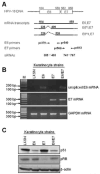

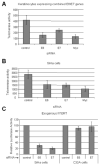
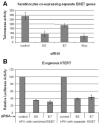
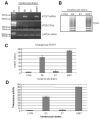
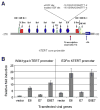
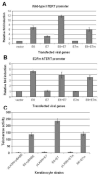

Similar articles
-
Cell-restricted immortalization by human papillomavirus correlates with telomerase activation and engagement of the hTERT promoter by Myc.J Virol. 2008 Dec;82(23):11568-76. doi: 10.1128/JVI.01318-08. Epub 2008 Sep 25. J Virol. 2008. PMID: 18818322 Free PMC article.
-
Human papillomavirus E6 and Myc proteins associate in vivo and bind to and cooperatively activate the telomerase reverse transcriptase promoter.Proc Natl Acad Sci U S A. 2003 Jul 8;100(14):8211-6. doi: 10.1073/pnas.1435900100. Epub 2003 Jun 23. Proc Natl Acad Sci U S A. 2003. PMID: 12821782 Free PMC article.
-
Telomerase activation by human papillomavirus type 16 E6 protein: induction of human telomerase reverse transcriptase expression through Myc and GC-rich Sp1 binding sites.J Virol. 2001 Jun;75(12):5559-66. doi: 10.1128/JVI.75.12.5559-5566.2001. J Virol. 2001. PMID: 11356963 Free PMC article.
-
Activation of telomerase by HPVs.Virus Res. 2017 Mar 2;231:50-55. doi: 10.1016/j.virusres.2016.11.003. Epub 2016 Nov 15. Virus Res. 2017. PMID: 27863966 Review.
-
Basic mechanisms of high-risk human papillomavirus-induced carcinogenesis: roles of E6 and E7 proteins.Cancer Sci. 2007 Oct;98(10):1505-11. doi: 10.1111/j.1349-7006.2007.00546.x. Epub 2007 Jul 23. Cancer Sci. 2007. PMID: 17645777 Free PMC article. Review.
Cited by
-
Do or Die: HPV E5, E6 and E7 in Cell Death Evasion.Pathogens. 2022 Sep 9;11(9):1027. doi: 10.3390/pathogens11091027. Pathogens. 2022. PMID: 36145459 Free PMC article. Review.
-
Human keratinocytes are efficiently immortalized by a Rho kinase inhibitor.J Clin Invest. 2010 Jul;120(7):2619-26. doi: 10.1172/JCI42297. J Clin Invest. 2010. PMID: 20516646 Free PMC article.
-
The biological properties of E6 and E7 oncoproteins from human papillomaviruses.Virus Genes. 2010 Feb;40(1):1-13. doi: 10.1007/s11262-009-0412-8. Epub 2009 Oct 17. Virus Genes. 2010. PMID: 19838783 Review.
-
Dysregulated microRNA Expression Relevant to TERT Promoter Mutations in Tonsil Cancer-A Pilot Study.Life (Basel). 2023 Oct 20;13(10):2090. doi: 10.3390/life13102090. Life (Basel). 2023. PMID: 37895471 Free PMC article.
-
Immortalization Reversibility in the Context of Cell Therapy Biosafety.Int J Mol Sci. 2023 Apr 23;24(9):7738. doi: 10.3390/ijms24097738. Int J Mol Sci. 2023. PMID: 37175444 Free PMC article. Review.
References
-
- Alfandari J, Shnitman Magal S, Jackman A, Schlegel R, Gonen P, Sherman L. HPV16 E6 oncoprotein inhibits apoptosis induced during serum-calcium differentiation of foreskin human keratinocytes. Virology. 1999;257(2):383–96. - PubMed
-
- Alonso MM, Fueyo J, Shay JW, Aldape KD, Jiang H, Lee OH, Johnson DG, Xu J, Kondo Y, Kanzawa T, Kyo S, Bekele BN, Zhou X, Nigro J, McDonald JM, Yung WK, Gomez-Manzano C. Expression of transcription factor E2F1 and telomerase in glioblastomas: mechanistic linkage and prognostic significance. J Natl Cancer Inst. 2005;97(21):1589–600. - PubMed
-
- Alonso MM, Fueyo J, Yung WK, Gomez-Manzano C. E2F1 and telomerase: alliance in the dark side. Cell Cycle. 2006;5(9):930–5. - PubMed
Publication types
MeSH terms
Substances
Grants and funding
LinkOut - more resources
Full Text Sources

